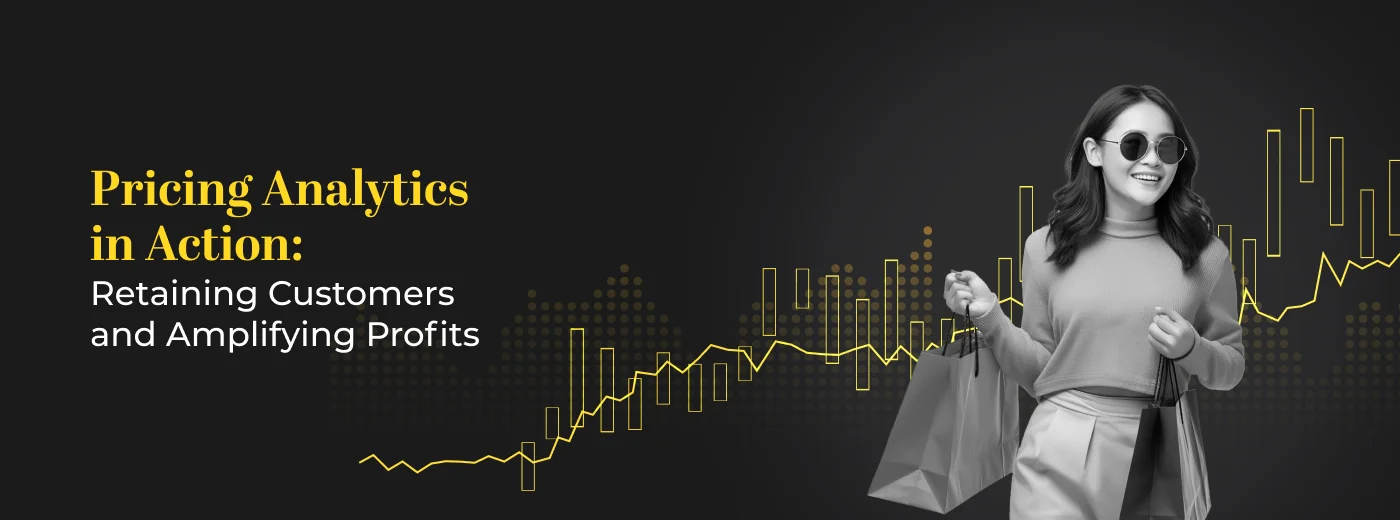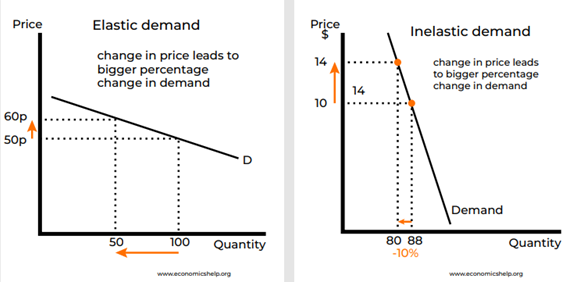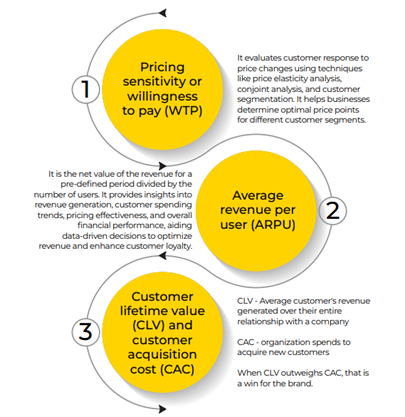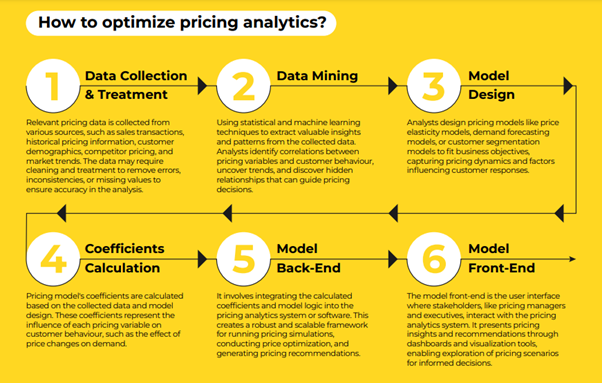
Sign up to receive latest insights & updates in technology, AI & data analytics, data science, & innovations from Polestar Analytics.
Let’s deep dive into how Pricing Analytics helps decode complex market behaviours and uncover revenue opportunities.
Platforms like Google Shopping, Trivago, Bankbazaar.com, Pronto, etc. allow customers to easily compare prices of the same product across providers. In many cases better the offer – the higher the sale.
Hence, pricing and analytics within an industry can have a crucial role in enhancing revenue and retaining customers in the long run.
data analytics pricing models utilizes predictive analytics to enable informed decisions on pricing strategies, ultimately leading to increased profitability.
In “Getting Pricing Right by Larry Montan, Terry Kuester, and Julie Meehan”- research shows that price management initiatives can increase a company’s margins by 2 to 7% in 12 months, yielding an ROI between 200 and 350 percent, clearly indicating that pricing metrics are highly important.
To make effective use of pricing analytics platform, it's essential to gain a deep understanding of your customer base and their purchasing behavior. This means gathering data concerning your current customers, including their purchasing behavior and likes.
Understanding Price Elasticity is useful in knowing your customers since it assists in identifying how sensitive they are to price changes in products.
Price elasticity gauges the way an alteration in the consumption of a commodity is connected with an alteration in price.
Formulaically, it's expressed as:
Price Elasticity of Demand = % Change in Quantity Demanded / % Change in Price
Elastic – Demand decreases when the price fluctuates.
Inelastic – Demand remains the same when price changes.

Transaction data of customers can be used to help leaders understand price elasticities, and cross-elasticities, and ultimately optimize pricing strategies.
Depicting the reciprocal connection between shifts in your pricing and variations in customer purchase & sales volumes, this analyses how sensitive customer demand is to changes in product prices.
Analyzing how a shift in the price of one product might influence the demand for other products, revealing the interplay among different goods within the consumers' market.
Advanced Pricing Analytics solutions can evaluate the following customer metrics: -

Dive into Dynamic Pricing and its significance in catering to the hyper-personalized consumer market.
Explore NowTesting different prices is another useful way of profit optimization through high-end pricing analytics solutions. Consider offering products or services at various price levels, like premium vs standard versions, and observe which one generates more revenue in the long term.
This is most useful while launching a new product or service. Testing various price levels before settling for one ensures that the chosen price maximizes company profitability. Firms can use disparate data analytics pricing models, including the Van Westendorp method, Choice-based Conjoint modelling (CBC), Gabor-Granger, and Econometric Demand Modelling to arrive at the ideal price.
One of the most potent applications of pricing analytics models would be customer segmentation into price tiers-that is, tiers created based on very specific purchasing behaviours and preferences. For example, if one segment of customers like to buy much more, it can be worth offering them higher discounts or reward points so that they remain loyal. For customer groups who do not buy often, discounting can act as incentives and induce more purchases.
In addition, to business research can be done to understand the reasons behind customers' preferences for your brand instead of a competitor's. It can tell you which among the given features or services most of your customers are attracted to so you can re-adjust your pricing accordingly. It can be done using research methods like focus groups, surveys and interviews.
You can stay ahead of your competition by tracking their models, discounts, and promotions is important. Use automated competitive intelligence tools to monitor competitor prices over a period without sacrificing market competitiveness and profit margins and adopt pricing analytics advantages.
Automated tools extract data for real-time dashboard. It serves as an early warning system for price and promotion movement. Brands, armed with this information, can anticipate an action by a competitor, map opportunities to win new customers and retain existing ones through promotions and discounts, while boost overall profitability.
Price optimizations are necessary for businesses to earn a good income and stand in competition with other players. By simulating product-level, cross, and market basket elasticity, firms can get to the best possible prices for all their range of products.
All these factors simultaneously can be considered to simulate the most lucrative price point.
But optimal pricing is not a one-time job. Firms have to change prices periodically in order to inform customers about price dynamics.
Using simulated models and systematically changing prices, companies can boost revenue and margins, fulfil customer expectations, and strengthen their market position, ultimately resulting in better financial performance.
Here are the steps for price optimization: -

Th Consider "TechPro," a company that deals in electronics with a specialty in manufacturing smartphones. TechPro is interested in achieving maximum profitability and attracting their target audience through the optimization of the price of their latest smartphone model, the "SmartX," by leveraging pricing analytics solutions.
Here's a hypothetical example of how pricing analytics case study example of how it can be applied to SmartX
Data Collection: Historical data on past smartphone models, including pricing, sales volume, customer demographics, and competitor pricing.
Data Mining: With data analysation, TechPro discovers that certain features like camera quality and battery life strongly influence customer purchasing decisions.
Model Design:TechPro develops a pricing model integrating production costs, desired profits, feature significance, and price elasticity to gauge customer responsiveness to price fluctuations
Coefficients Calculation:Using statistical techniques, TechPro estimates coefficients for different attributes like camera quality, battery life, and price.
Model Back-End:This allows TechPro to predict how changes in pricing and features will affect the sales volume of SmartX.
Model Front-End: TechPro develops an intuitive user interface that allows decision-makers to enter various pricing scenarios and view the anticipated results in terms of profit, revenue, and sales volume.
TechPro simulates price changes, such as increasing the SmartX's price by $50 for improved camera features, in order to forecast changes in sales and revenue.
Optimization & Simulation: TechPro simulates price changes, like raising SmartX's price by $50 for better camera features, predicting resulting sales and revenue shifts.
Based on the simulation results, TechPro decides on an optimal pricing strategy for SmartX.
Learn how we've built a winning pricing analytics framework for an Alcoholic Beverage giant increasing 10% contribution to the revenue & increased market share.
Now that we’ve seen pricing analytics in action, look at some of the frequently asked questions!
Retailers heavily depend on promotions as a component of their pricing strategy, and are typically managing thousands of offers by SKUs, categories, and channels.
Metrics of key interest to retail include:
Evolving tools of pricing also optimize promotion calendars, impose compliance, and interact with POS and promotional systems, to help retailers attain profitability and customer loyalty.
In addition, small and medium enterprises can benefit from enterprise-grade pricing analytics. The price democratization of these solutions has ensured that advanced tools are now accessible to smaller firms.
Appropriate solutions include:
Next era of pricing analytics can fully benefit from the Agentic AI by:
Most critical pricing metrics every business needs to monitor are:
Next era of pricing analytics can fully benefit from the Agentic AI by:
Businesses can influence their own fate in the ever-changing field of pricing analytics. The pursuit of maximum profitability develops as they segment clients and rivals and adjust pricing strategies. However, it poses fascinating questions, so the journey doesn't end here.
How will artificial intelligence further transform pricing analytics? What role will customer data play in the next pricing revolution? The answers await those who dare to innovate and explore.
So, as we adapt to new age pricing analytics services, the price tag isn't just a number. It's a story waiting to be uncovered, a strategy yet to be perfected, and a customer experience yet to be optimized. We at Polestar Analytics are providing valuable support to businesses looking to optimizing pricing strategies for retention through pricing analytics services. By leveraging our expertise as an AI and Data Analytics powerhouse, we help unlock the full potential of their organisation data.
About Author

Marketing Consultant
Data Alchemy can give decision making the golden touch.